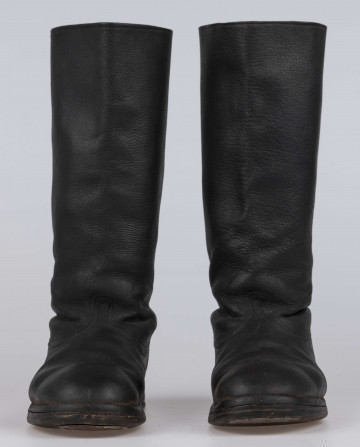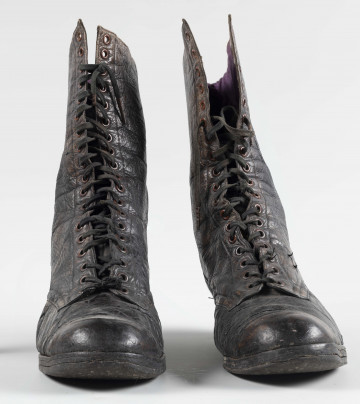
Leather boots `tyszowiaki`
1910 — 1930
National Museum in Lublin
Part of the collection: Folk craft of the Lublin Region (19th/20th c.)
Women's black shoes, called trzewiki or ciżmy, were made by a shoemaker. They were purchased at the market in Bychawa in 1935 and were worn until 1940. They were made of black grain leather, with a canvas lining inside. They are fitted, high - they reached to the middle of the calf, laced along the entire length of the upper (20 cm) with a pink ribbon. The nose is tapered and bevelled at the end. The cut of the sole (length 25 cm) in both shoes is identical, so there is no distinction as to which leg fits - the left or the right. This used to be a common practice, as the shoemaker had only one pattern, according to which the shoes were prepared, and they developed as they were worn. The model shown here has a 5 cm high leather heel.
Shoes of this type were worn with festive costumes. One pair could be used for several years, and if they were in good condition, after the owner's death the shoes were passed on to the next person in the family. They were cared for by cleaning them with animal fat or beeswax, and sometimes blackened with soot. They were worn only at important moments, when a complete outfit was required; for example, a woman would walk several kilometres to church barefoot or in everyday shoes, and before entering the temple she would clean her feet on the grass or in a nearby river and put on her clippers. She would take them off after mass and return home barefoot, with her shoes slung over her shoulder. It was a very common practice, adopted throughout the country, due to the high cost involved in buying them.
Author / creator
Dimensions
cały obiekt: height: 20 cm
Object type
folk costume
Technique
sewing
Material
natural leather
Creation time / dating
Creation / finding place
Owner
The National Museum in Lublin
Identification number
Location / status

1910 — 1930
National Museum in Lublin

1910 — 1930
National Museum in Lublin

1918 — 1939
National Museum in Lublin
DISCOVER this TOPIC
National Museum in Szczecin
DISCOVER this PATH
Educational path